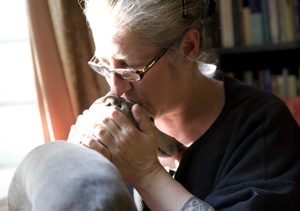Two taxidermists use their skills to honor our furry friends.
Tia Resleure’s apartment is filled with animals. There are dogs, pigeons, monkeys and goats, and a dray of squirrels on the table. Two slight Italian greyhounds dance around the house, while another is mounted on the wall. “I don’t have a problem decorating my house with taxidermy; I think it’s beautiful,” says Resleure, who sits on a chaise lounge, stroking a dog’s ear.
Resleure has an extensive collection of Victorian and Edwardian taxidermy, as well as an expanding portfolio of her own work (acaseofcuriosities.com). The entryway to her San Francisco apartment holds one of Resleure’s “diva-pigeons,” a series she is working on. The white pigeon, with its cocked head and downward gaze, is in stark contrast to the blue silk gown that envelops it. “Taxidermy, for me, is like playing with dolls,” she says.
From the traditional taxidermists who mount their husbands’ hunting trophies in the basement, to the artsy kids who tattoo animal hides in studios, taxidermy is gaining popularity among women. “It’s going through a real renaissance right now,” says Resleure. “There are a lot of young pups coming up in the art world.”
One of these young pups is a San Francisco artist named Maya Bookbinder, whose day job is actually binding books. She began to love taxidermy in the nature lab at Rhode Island School of Design. “I was doing taxidermy repair work and then I just got kind of obsessed,” says the 23-year-old.
Eventually, Bookbinder came to San Francisco to study with Resleure. Under Resleure’s instruction, she learned to work with Italian greyhounds. “Italian greyhounds are so hard to do, because you can see everything,” says Resleure, pointing to the thin-faced dog on the wall. As if to reinforce the point, one of her Italian greyhounds walks by, shaking its veiny legs.
Resleure has a fondness for animals—both living and dead. “A lot of people have said that I’m insensitive to animals, but I love them,” she says. It was Resleure’s connection to animals that brought her to taxidermy in the first place. Growing up in a dysfunctional home, she turned to animals to escape the world of abuse. “The dogs were the only people who listened to me,” she says, laughing. The one connection her family shared was their love of nature—her parents loved natural history and her grandfather had a taxidermy collection. Resleure says that as a child her favorite book was the Big Golden Book of Fairytales, which centers on anthropomorphic characters. “That’s sort of what my collection feels like,” she says, gesturing at the diorama of sword-fighting frogs in pirate shirts.
Resleure returns to Aissi, the Italian greyhound mounted on the wall—it was her first greyhound mount and a pet she loved dearly. She stares at the face and says, “You can’t put the dog’s spirit in it…I look at this and I see a beautiful animal, but I don’t see my dog.”
Resleure usually doesn’t do mounts of other people’s pets, and she doesn’t use any endangered species. “I think about the ethics of what I do a lot,” she says. But Resleure, like many taxidermists, has come under sharp attack from animal rights activists. “They say that I’m going to burn in hell,” she says, adding that their posters of animals are more gruesome than anything she has mounted.
Bookbinder also contemplates the morals of her work. A vegan for some time, she understands people’s aversion to dead animals, but says she “just [doesn’t] have the baggage about it that some people do.”
Neither Resleure nor Bookbinder are hunters so they get their animals in other ways—they are roadkill, donations, purchases or pets that have died. “People used to bring roadkill to my door. It’s really just recycling,” says Bookbinder. But her San Francisco apartment is too small for her to stuff big animals; she mostly works with pelts now.
Resleure and Bookbinder both have big dreams for their taxidermy careers. “I’d love to learn to do birds,” says Bookbinder excitedly. Resleure dreams of opening a bar to house her taxidermy, “I’d like to do the best Italian greyhound mount in the world, better than the one in the British Museum.”
